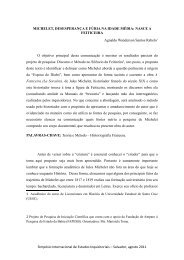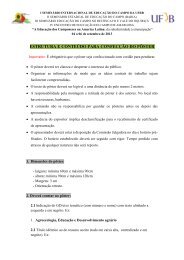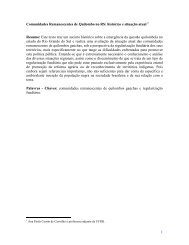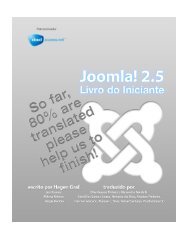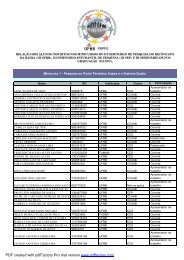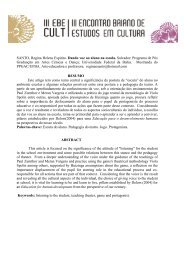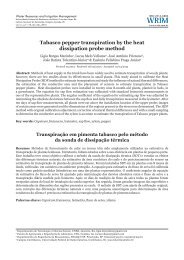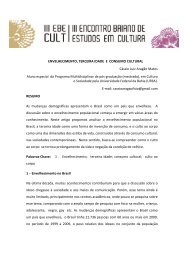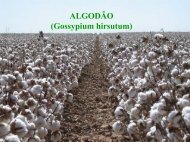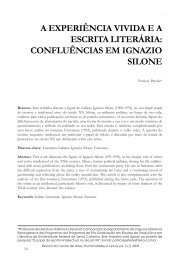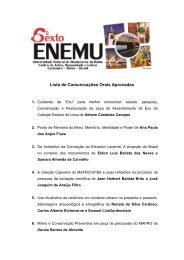Sensor placement for irrigation scheduling in banana using ... - UFRB
Sensor placement for irrigation scheduling in banana using ... - UFRB
Sensor placement for irrigation scheduling in banana using ... - UFRB
You also want an ePaper? Increase the reach of your titles
YUMPU automatically turns print PDFs into web optimized ePapers that Google loves.
<strong>Sensor</strong> <strong>placement</strong> <strong>for</strong> <strong>irrigation</strong> <strong>schedul<strong>in</strong>g</strong> <strong>in</strong> <strong>banana</strong> us<strong>in</strong>g micro-spr<strong>in</strong>kler system 17Table 1. Physical characteristics of the soil of experimental areaDepth(m)GranulometricPorosity Soil Soil water contentcomposition (%)Textural(%) density (mclassification3 m -3 )Total sand Silt Clay Macro Micro(kg dm 3 )-10 kPa - 1500 kPaHydraulicconductivity(m s -1 x 10 -7 )0.0–0.2 57.7 09.9 32.4 Sandy clay loam 13.34 26.34 1.50 0.2106 0.1495 160.000.2 – 0.4 51.7 08.9 39.4 Sandy clay loam 11.91 28.44 1.48 0.2400 0.1709 45.280.4 – 0.6 49.3 37.4 37.4 Sandy clay loam 11.92 26.14 1.52 0.2195 0.1625 200.00coefficient (Kr) based on the surface of the soilwhich was effectively covered by <strong>banana</strong> leafarea. The frequency of <strong>irrigation</strong> was daily. Thesoil moisture was monitored at several differenthorizontal distances (R) and also depths (Z), <strong>in</strong> anet of 0.20 x 0.20 m on a vertical plane, start<strong>in</strong>gfrom the plant and follow<strong>in</strong>g the direction of theplant row, with “R” limit set at 1.0 m and a “Z”limit also set at 1.0 m. TDR probes were <strong>in</strong>stalledhorizontally at the different po<strong>in</strong>ts of the mesh, sothat one could obta<strong>in</strong> the soil water content <strong>in</strong> thewhole the plane (Figure 1).Ew<strong>in</strong>g, 1997) and of root length density (RLD)was obta<strong>in</strong>ed us<strong>in</strong>g the follow<strong>in</strong>g equation:RLD =L Vrwhere:RLD - density of root lengths, m m -3L r- length of roots, mV r- volume of samples, m 3Soil water content measurements were startedthirty days after <strong>in</strong>stallation. Read<strong>in</strong>gs were made<strong>in</strong> each plane <strong>for</strong> a period of five days by us<strong>in</strong>g aTDR attached to a datalogger, programmed tostore soil water content every 10 m<strong>in</strong>. At eachpo<strong>in</strong>t of the grid (R, Z) the extracted water depth[LE(R, Z)] was calculated based on the differencesof soil water content measured straight after<strong>irrigation</strong> (time correspond<strong>in</strong>g to that when the<strong>in</strong>filtrated water would have reached the deepestprobe <strong>in</strong> the plane (k + 1), and a time be<strong>for</strong>e thenext <strong>irrigation</strong> (k + 2), as shown <strong>in</strong> Figure 2.r(2)Figure 1. Monitor<strong>in</strong>g of soil water content <strong>in</strong> the regionaround the root system of <strong>banana</strong> plants, us<strong>in</strong>g time doma<strong>in</strong>reflectometry (TDR) probesTDR probes were made with rods of 0.1 mspaced with distances of 0.017 m between them,as used by Silva et al. (2009), with the calibrationequation given by Eq. (1):3 2θ= 6. 438ε − 5. 5246ε + 2. 0373ε−0.0745 (1)where:e - bulk dielectric constant of the soilAs the TDR probes were <strong>in</strong>stalled, samples of0.0005 m 3 of soil and roots were removed fromthe profile <strong>in</strong> order to establish root distributionof the <strong>banana</strong> crop. Roots were separated fromthe soil us<strong>in</strong>g a wash<strong>in</strong>g process (Bohm, 1979),and then digitalized us<strong>in</strong>g a scanner (Coelho &Or, 1998). Root length “Lr” (cm) was obta<strong>in</strong>edwith the use of the Rootedge software (Kaspar &Figure 2. Identification of Time Po<strong>in</strong>ts (k + 1) and(k + 2)Extracted water by the plant was estimatedat different locations on the grid [LE(Ri, Zi)] byus<strong>in</strong>g Eq. (3).LE ( RZ)= θk−θk,( + 1) ( + 2)(3)where:q (k + 1)- soil water content immediately after<strong>irrigation</strong>, m 3 m -3Water Resources and Irrigation Management, v.1, n.1, p.15-23, 2012.



